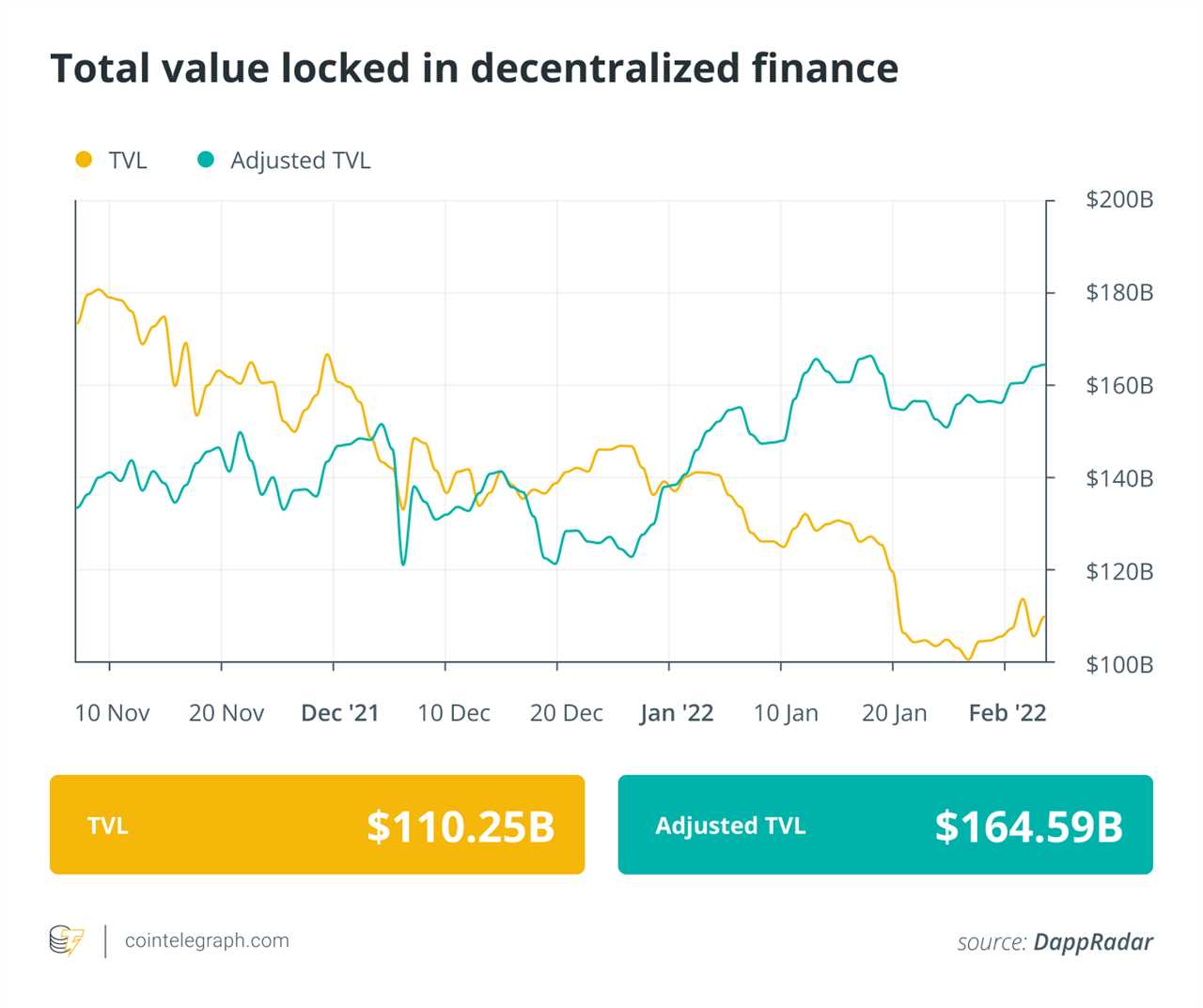
Welcome to the latest edition of Cointelegraph’s decentralized finance newsletter.
It’s been a tumultuous week of doxxing, hacks, bailouts and new highs in the decentralized finance space. Read on to recap the most impactful stories of the last seven days.
This article represents a conspectus of the full email newsletter. For the full edition, sign up via the box below.
Wonderland lost in no mans amid Sifu saga
Following the revelatory identification of previously anonymous QuadrigaCX co-founder Michael Patryn as the founder of DeFi protocol Wonderland — known on social media as @0xSifu — a subsequent community vote decided upon the permanent closure of Wonderland for outstanding security concerns.
The saga commenced when DeFi investigator Zachxbt doxxed Patryn to be Sifu, a figure with a notorious reputation within the digital asset space for alleged fraudulent and illicit activity, most notably regarding the $145-million losses incurred at Canadian-based cryptocurrency exchange QuadrigaCX in December 2018.
Having been made aware of Sifu’s real identity one month prior to this week’s announcement, Daniele Sestagalli, co-founder of Wonderland and stablecoin protocol Abracadabra, posed a crucial question to the community members: “Do we wind down or continue to fight for the aspect of an investment DAO being a revolutionary new organization?” Sestagalli stated his personal preference to be the latter, to fight.
From a technical perspective on Jan. 15, Wonderland recorded a near all-time high of $776.64 million in total value locked, or TVL. However, as a consequence of the exposure, the TVL figure dropped substantially to $78.57 million on Jan. 25, marking an 89.9% demise. At the time of writing, the figure has somewhat recovered to $408.59 million.
In true Web3 style, the decision to “Wind down Wonderland and give the treasury back to its holders” was put to a community snapshot vote. The two-day governance participation resulted in a split decision, an inconclusive majority with 116,000 TIME tokens allocated to the decision of no, and 95,000 to yes.
In response to this, co-founder Sestagalli assessed that “the duty of the team is to enact the will of the token holders. As the vote is so close to 50/50 there is only one path forward, it is to reimburse/unwind,” confirming this in a follow-up tweet.
1/
— Daniele never asks to DM (@danielesesta) January 30, 2022
Wonderland experiment is coming to an end. It is clear from the vote that the community is divided. The core and heart of Wonderland is still the community. If we cannot find agreement on wether to continue or not, it means that we failed.
Discussions within the community are vehemently ongoing in a bid to find an accommodating solution to the Wonderland saga for all involved. Proposals currently at the forefront are a merger with Abracadabra or a transition to a DAO structure with greater transparency.
Wormhole exploited for $321M, parent bails it out
DeFi bridging protocol Wormhole suffered a significant security exploit on its network this week to the tune of 120,000 Wrapped Ether (wETH) tokens, equivalent to $321 million at the time of impact — the second-largest hack in the history of decentralized finance behind Poly Network’s seismic $610-million breach in August 2021.
Wormhole is known within the industry for its cross-chain token bridge service in which users can transfer crypto assets between chains such as Ethereum, Solana and Polygon, among others, without interacting with centralized exchanges.
After analyzing blockchain data, it was uncovered that the attacker minted 120,000 wETH on Solana and then proceeded to redeem 93,750 wETH for Ether (ETH) worth $254 million. The remaining wETH was swapped for Solana (SOL) and USD Coin (USDC) on Solana.
Following on from this, the hacker utilized a portion of the funds on an asset-buying spree that included SportX (SX), Meta Capital (MCAP), Finally Usable Crypto Karma (FUCK) as well as the highly anticipated soon-to-be-released asset, Bored Ape Yacht Club Token (APE).
In response, the Wormhole team pledged to the community that the token supply, in addition to the one-to-one backed asset total, would be fully reinstated and is offering a generous whitehat bug bounty reward to the malicious entity for full recompensation of the funds.
The hack risked serious cascading ramifications for protocols and platforms within the Solana ecosystem that rely on the wETH supply for collateral. If their assets were not backed with wETH, investors would have been unable to utilize the service, perhaps lose confidence, and, therefore, short the asset. Solana fell around 13% in the fallout of the news.
In a fortuitous turn of events, Wormhole’s parent company, Jump Crypto, stepped in to bailout the platform and restore all lost funds, an action confirmed by Wormhole in a tweet.
1/2
— Wormhole (@wormholecrypto) February 3, 2022
All funds have been restored and Wormhole is back up.
We're deeply grateful for your support and thank you for your patience.
Despite a resolution for the platform’s affected users, concerns still remain as to the whereabouts of the $321 million in lost funds, in addition to the intentions of the hacker within the marketplace.
Ethereum hash rate hits new ATH in PoS transition
Quantitative insights from popular data aggregation site Glassnode this week revealed that the hash rate for Ethereum reached a new all-time high of 1.11 petahash per second (PH/s) on Jan. 28, surpassing the previous figure of 1.08 PH/s established just 15 days prior.
Fluctuations in the hash rate of proof-of-work (PoW) networks such as Bitcoin and Ethereum are prime indications of additional nodes joining the network, scenarios that ultimately result in higher security and more expansive decentralization of the network.
#Ethereum $ETH Mining Difficulty just reached an ATH of 13,119,856,939,346,200
— glassnode alerts (@glassnodealerts) February 1, 2022
Previous ATH of 13,076,339,792,989,700 was observed on 23 January 2022
View metric:https://t.co/s9t4z96wMA pic.twitter.com/Cxk3JMg1Qp
In December 2021, participants of the Ethereum network implemented the Arrow Glacier upgrade, an initiative designed to delay the activation of a coding mechanism that is set to halt production of mining activities on the network, otherwise known as the “difficulty bomb.”
It is widely expected that Ethereum’s transition to PoS will occur during the latter half of 2022, with Arrow Glacier being the final upgrade, a market sentiment recognized by one of the core developers facilitating the upgrade, Tim Beiko, during a recent commentary.
Token performances
Analytical data reveals that DeFi’s total value locked slightly increased by 8.87% across the week to a figure of $109.92 billion, attempting to recover from the market downturn in recent weeks.

Tezos (XTZ) reported the highest score in the top 100 following its partnership with Manchester United at 31.60%. Maker (MKR) came in second with a respectable 25.54% gain, while Convex Finance (CVX) recorded a 19.46% increase. Curve DAO Token (CRV) and Oasis Network (ROSE) gained 15.29% and 11.79%, respectively.
Interviews, features and other cool stuff
- Blockchain startups grow as global VC funding generated $25.2 billion in 2021
- Web3 developer growth hits an all-time high as ecosystem matures
- Is the rise of derivatives trading a risk to retail crypto investors?
Thanks for reading our summary of this week’s most impactful DeFi developments. Join us again next Friday for more stories, insights and education in this dynamically advancing space.
Title: Finance Redefined: Wonderland reveal and Wormhole hacked, Jan. 28–Feb. 4
Sourced From: cointelegraph.com/news/finance-redefined-wonderland-reveal-and-wormhole-hacked-jan-28-feb-4
Published Date: Fri, 04 Feb 2022 20:00:00 +0000






